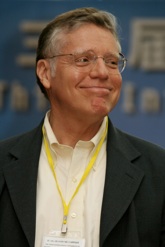John Beebe, M.D., is author of the 2005 book, Integrity in Depth and co-author, along with Virginia Apperson of the 2009 book, The Presence of The Feminine in Film. You may recall that Dr. Beebe, was my guest on shows #166 on the feminine in film and #140 which dealt with Jungian Typology. Dr. Beebe is a Jungian analyst in practice in San Francisco. He received degrees from Harvard College and the University of Chicago medical school. He is a past President of the C.G. Jung Institute of San Francisco, where he is currently on the teaching faculty, as well as Assistant Clinical Professor of Psychiatry at the University of California Medical School, San Francisco. He is a Distinguished Fellow of the American Psychiatric Association. An avid film buff, Dr. Beebe frequently draws upon American movies to illustrate how the various types of consciousness and unconsciousness interact to produce images of Self and shadow in the stories of our lives that Jung called individuation. Dr. Beebe is particularly well known for his elaboration in C.G. Jung’s theory of psychological types.
A popular lecturer in the Jungian world, Dr. Beebe has spoken on topics related to the theory and practical applications of analytical psychology to professional and lay audiences throughout the United States as well as in Canada, China, Denmark, England, France, Italy, Germany, Israel, Mexico, and Switzerland. Dr. Beebe is the Founding Editor of The San Francisco Jung Institute Library Journal, a quarterly of reviews with an international readership, and he was the first American co-editor of the London-based Journal of Analytical Psychology.
Dr. Beebe has contributed many book chapters and published in a wide range of journals. For eample, with Donald Sandner, he is the author of “Psychopathology and Analysis,” an article on Jungian complex theory used in many training programs, and with Thomas Kirsch and Joe Cambray the author of “What Freudians Can Learn from Jung.” Dr. Beebe is the author of the book Integrity in Depth, a study of the archetype of integrity.
Dr. Beebe’s reviews and articles about movies have reached a wide audience. Following up on Jung’s theory of psychological types, Beebe developed an archetypal model of a dialogical self wherein conscious functions contend with functions in the shadow. A person’s superior (preferred] function is the hero (or heroine), most closely allied with a semi-conscious function called the anima (or animus). An auxiliary function (the good parent) may be counteracted by a shadowy Witch/Senex function, and a child-like tertiary function by a more juvenile Trickster. The Anima may find itself forced to compete with a demonic personality function which threatens to destroy it.
Check out the following Psychology CE Courses based on listening to Shrink Rap Radio interviews:
Jungian Psychotherapy Part 1 (6 CEUs)
Jungian Psychotherapy Part 2 (7 CEUs)
Jungian Psychotherapy Part 3 (7 CEUs)
Jungian Psychotherapy Part 4 (6 CEUs)
Jungian Psychotherapy discounted Package of the Three Above (20 CEUs)
Wisdom of The Dream (4 CEUs)
Positive Psychology (6 CEUs)
Get our iPhone/Android app!
A psychology podcast by David Van Nuys, Ph.D.
Podcast: Play in new window | Download
Subscribe: Apple Podcasts | RSS

Cool analysis, though on the boat, I didn’t get the impression that Jung was being snobbish about the arrangements with the rooms, I felt he was slightly embarressed by the issue. I thought the anti-semitism often levelled at Jung was taken down in that scene where Jung doesn’t seem to see the issue in Psychoanalysis being basically all Jewish at the time.
Thank you for your interesting and informative discussion of Cronenberg’s film “A Dangerous Method.” I’m curious about something. In all the discussions and articles I’ve come across so far, no one has mentioned John Kerr’s book “A Most Dangerous Method”, which discusses this case in great depth, and which was first published in 1993 (admittedly, you may have mentioned it in passing as “the book about” Ms. Speilrein). Everyone mentions the play on which the movie is based…but, isn’t the title of the movie rather obviously taken from the book? What is your opinion about the accuracy of what Kerr presents in his book. I see now that the book is back in print (and available in audio)…so, I would be good to hear your views on this.
Since everyone feels compelled to comment on the literal accuracy of the sexuality in the film, I thought I might offer at least one comment on this. We are, after all, talking about events that happened 100 years ago. Sexuality, as such, was not then what it is to us today. I suspect holding hands and kissing may have been even more scandalous then than bondage and discipline is to us today…at least in a therapeutic relationship.
Again, thank you both for this very interesting discussion!
Jon,
I’ve forwarded your questions about the Kerr book to Dr. Beebe. I’m hoping he may respond here. I think you make a good point in your last paragraph above about differences in sexual attitudes between then and now.